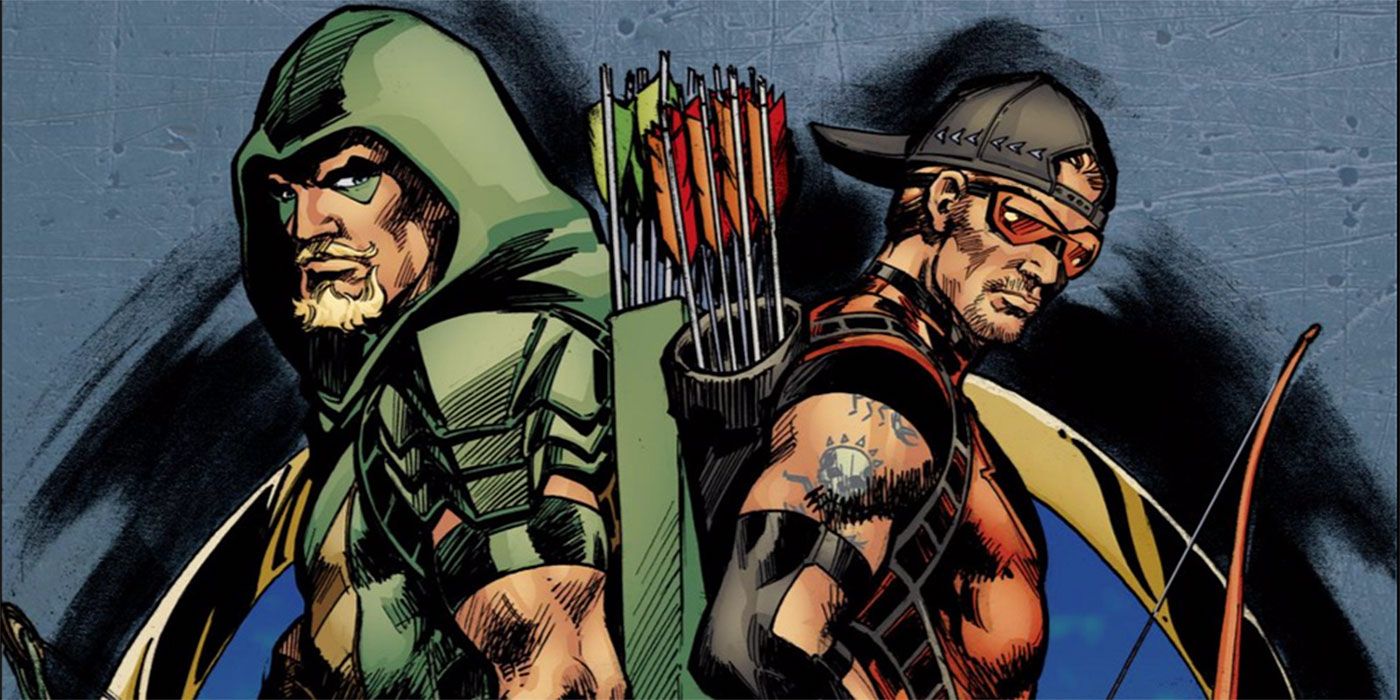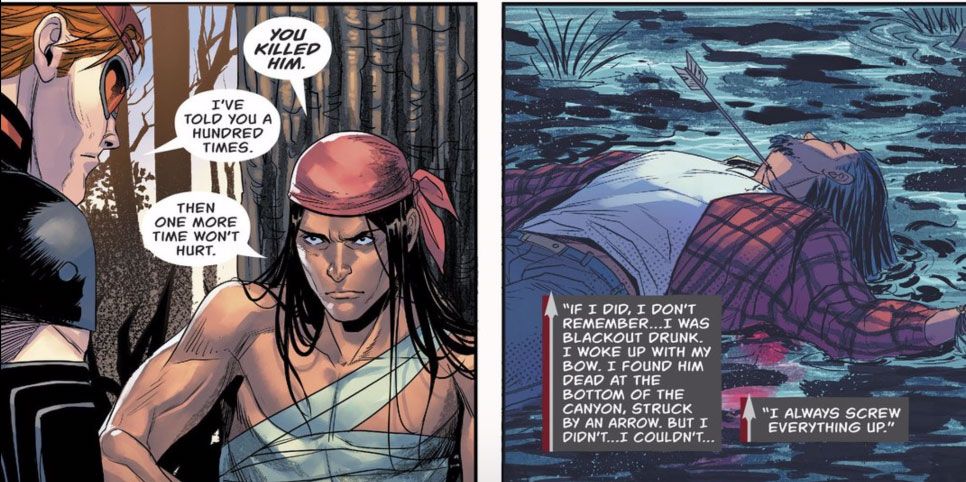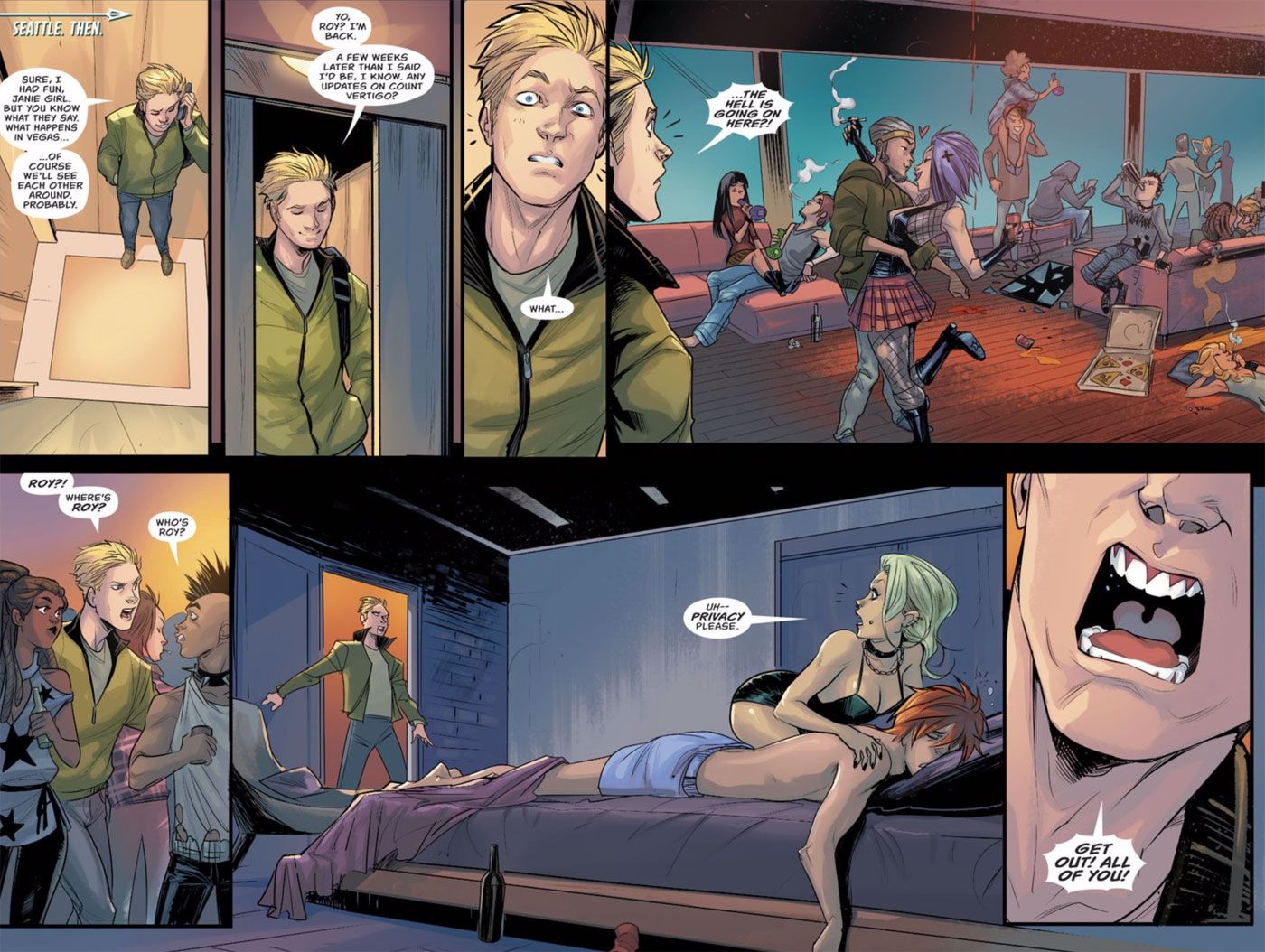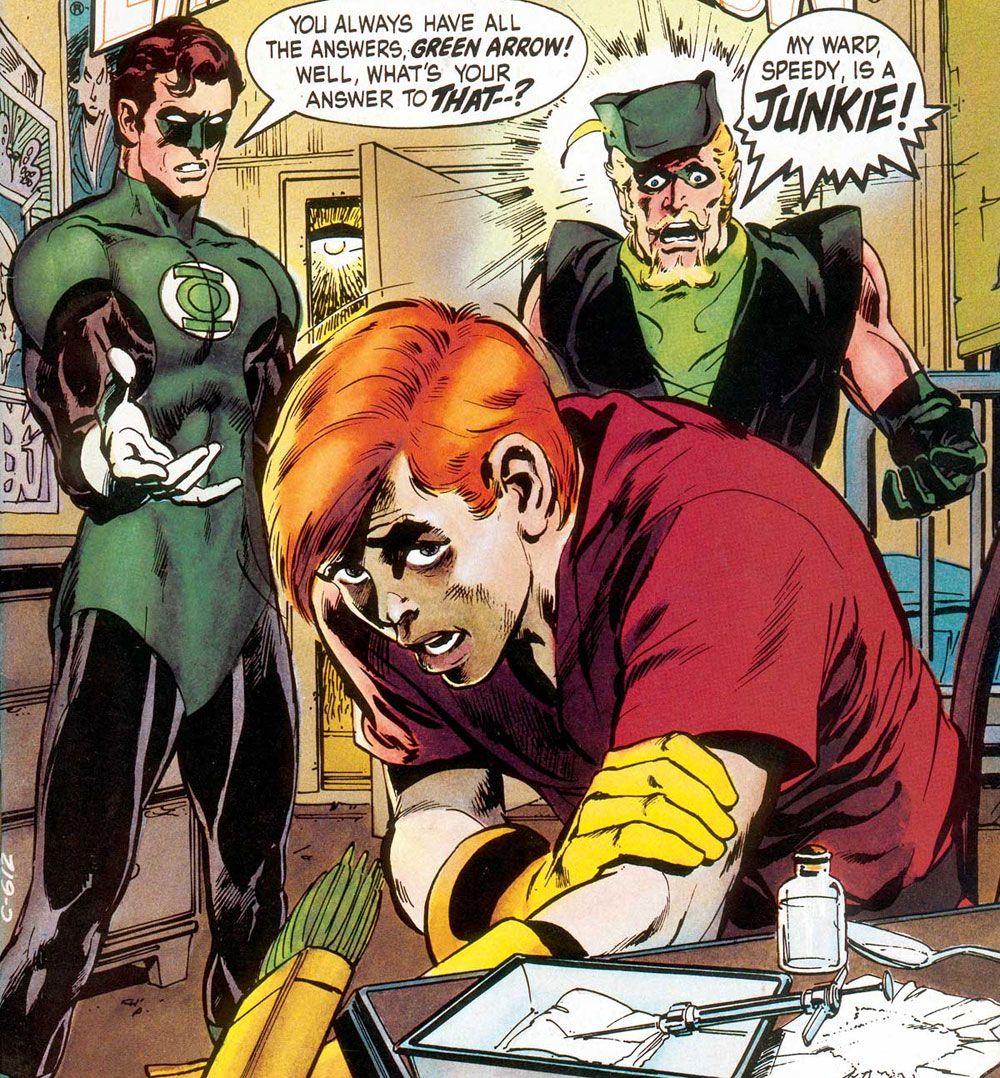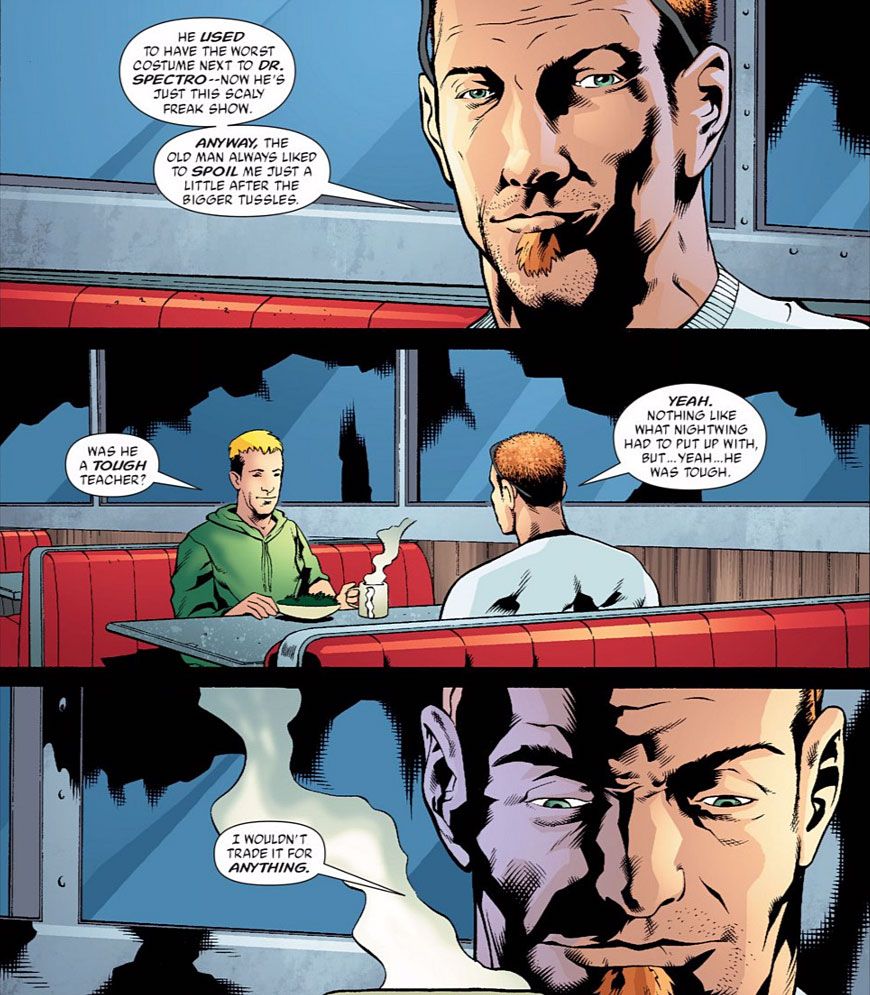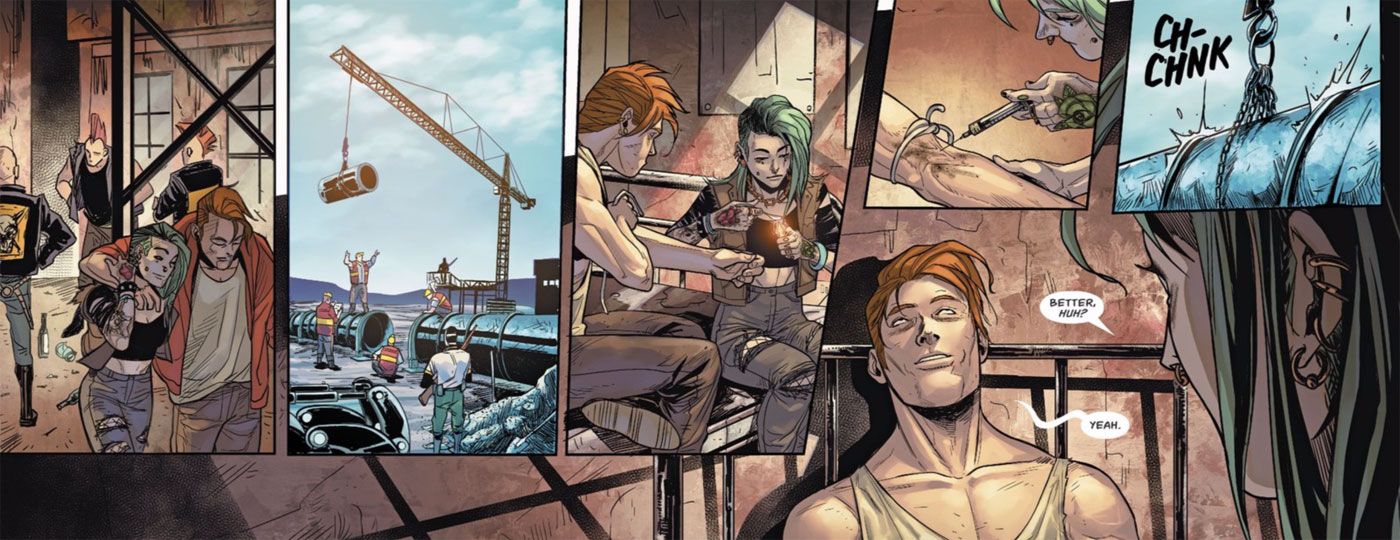SPOILER WARNING: The following article contains spoilers from "Green Arrow" #19 by Ben Percy, Eleonora Carlini and Mirka Andolfo
The latest issue of DC Comics' “Green Arrow” marked the second installment of the story arc “The Return Of Roy Harper” and, as you may have guessed, the story has been about, well...the return of Roy Harper.
Surprise!
But really, as much as the arc is about the literal reintroduction of Roy into Ollie Queen’s life for the first time since Rebirth, it’s also doing a considerable amount of leg work in rebuilding some important narrative themes from the “Green Arrow” stories of the pre-Flashpoint universe -- brick by self-destructive brick.
They've Got Issues
“The Return of Roy Harper” has been anything but a smooth sailing reunion for Green Arrow and Speedy. Instead, it’s laser focused on the rocky, enabling, and sometimes dangerous ways their lives had been entangled in the past, while simultaneously telling a story in the present about a transparent Dakota Access Pipeline analogue that fits right into the social justice focus of the “Green Arrow” book as a whole.
Roy, in a return to an origin more in keeping with his pre-Flashpoint self, reveals that he was raised on a Native American reservation before a mysterious incident resulted in the death of his adoptive father. His adoptive brother, an indigenous man named Bird, blames Roy for their father’s death and Roy -- likely care of his substance abuse problems -- is unable to refute the claims with any clarity. All he knows is that he was drunk, there was some sort of conflict, and then his adoptive father was dead with an arrow protruding from his chest. Naturally, Bird isn't eager to forgive Roy, nor is he looking too intently for any other potential culprits.
This, unsurprisingly, drove Roy out of the reservation and into the streets of Seattle, where he lived as a vagrant until he connected with Ollie after pickpocketing him in a mall. Ollie, thanks to his perpetually bleeding heart, takes Roy in, giving him a place to stay and a hot meal (chili, of course.) It doesn’t take long (seriously, it takes, like, a few hours max) for Roy to deduce Ollie’s vigilante secret identity, and from there, they’re off to the races.
At this point the story continues to deviate from its New 52 incarnation by positing that Roy was more than just the Green Arrow’s “tech guy” and, in fact, actually made a career as his sidekick, Speedy -- a point of some contention during the New 52, and a necessary update to make Roy’s on-panel history fall a bit more in line with the occasionally discussed version of his past presented in the Rebirth prelude “Titans Hunt,” and the currently ongoing “Titans.”
From there, however, the story begins to take a few more of its New 52 cues. Flashbacks in Issue #19 establish the rapid decline of Roy and Ollie’s partnership, as Roy’s addictive tendencies spiraled out of control. A secret house party in Ollie’s penthouse goes awry, and Roy gets caught. He’s drunk, belligerent, and has no short supply of property damage on his resume.
The ensuing fight between the boys lands Roy back on the street and, eventually, leads him to fall even further into his self destruction by becoming addicted to heroin.
Rock Bottom and Beyond
Roy’s struggles with addiction have been narrative staples of the “Green Arrow” world since back in 1971, after Denny O’Neil and Neal Adams’ “Snowbirds Don’t Fly” arc of “Green Lantern/Green Arrow.” The story, as part of O’Neil and Adams’ ongoing effort to modernize Green Arrow and Green Lantern away from their Golden Age roots, was about Ollie coming to realize that his focus on society’s problems at large had allowed him to be completely blind to the problems unfolding right in front of him.
It’s a heavy handed parable, with an even heavier handed (now iconic) cover of Roy literally shooting up as Ollie bursts into the room proclaiming “My ward, Speedy, is a junkie!”
Wrapped up in a tight two issues, the arc provided a thematic pivot point that would go on to effect Roy’s place within the DCU at large for decades to come. From there, all bets were off as far as Roy and his vices were concerned. He became the poster child for consequences in superhero narratives; a perpetually re-told cautionary tale.
Eventually, in the pre-“Flashpoint” continuity, these parables lead into a story that landed him a daughter via a torrid, morally dubious affair with a League of Assassins villain named Cheshire. With his daughter, his patchwork past, and his not-so-great decision making track record in tow, Roy’s existence in “Green Arrow” stories became rife with potential for any number of themes, ranging from the on-again-off-again bad blood between he and Ollie, to jilted relationship between himself and Ollie’s biological son, Connor Hawke; to the occasionally near-parental bond between he and Dinah Lance.
These sorts of stories would continue to weave in and out of “Green Arrow” proper, upping the personal stakes for Ollie’s involvement in the corners of the DCU outside of Star City, wherever Roy decided to show up, both before his death and after his resurrection.
In the post-“Flashpoint” world, Roy’s vices were “scaled back” to alcoholism. His time spent as a junkie, his affair with Cheshire, and his daughter, were removed -- though a potential connection between Cheshire and Roy was half heartedly teased at several points during the “New 52” version of “Red Hood and the Outlaws.”
Despite the relative downgrade, the focus on Roy’s persistent ability to screw up was otherwise not all that changed. The duration of the “New 52” featured no shortage of stories about the explosively bad relationship between himself and Ollie, a strange turn with suicidal depression (that eventually landed him in Alcoholics Anonymous with Killer Croc as his sponsor. No, really.) And a few comedically bad get-rich-quick style business ventures.
What was largely missing was any real reaction or connection between these screw-up stories and Green Arrow. Save for a handful of flashbacks, one or two brief cameos, and maybe a dozen or so offhanded mentions, Roy and Ollie spent the full five years time of the New 52 scarcely having anything to do with one another, leaving Roy’s readily tapped penchant for making a mess mostly relegated to one or two note throwaways.
Returning to the Fold
With the reformation of Roy’s tumultuous past in conjunction with his time spent as Green Arrow’s sidekick, “The Return Of Roy Harper” is planting the seeds of a “rebirth” for the entire “Green Arrow” focused corner of the DCU. Though the story on the surface is directly in keeping with the creative team’s Rebirth mission statement of focusing on social justice zeitgeist plots, it’s also the first major attempt since the renewal of Ollie and Dinah's romance in the "DC Universe: Rebirth" one shot from nearly a year ago to rebuild some of what the New 52 stripped away from the "Green Arrow" mythology.
Since it’s inception, this new run of “Green Arrow” has been consistently strong, arguably one of Rebirth's most successful returns to a character’s base DNA. That said, these successes seem to have come at the cost of sequestering Ollie into his own pocket of the larger shared universe. Thus far, in it’s 19 issues, the only major character that’s been allowed to participate in other stories has been Black Canary (who, in fairness, has been pretty busy across “Birds of Prey” and the new “Justice League of America” titles.)
“The Return Of Roy Harper”, and the subsequent solidification of Roy’s ambiguous post “Rebirth” history, represents a major step in the triumphant return of “Green Arrow” to a status quo that will actually allow for participation and communication between it and other books. And, with the next arc’s title solicited as “The Rise of Star City,” it looks like this is a path that the “Green Arrow” team is very eager to continue down.

